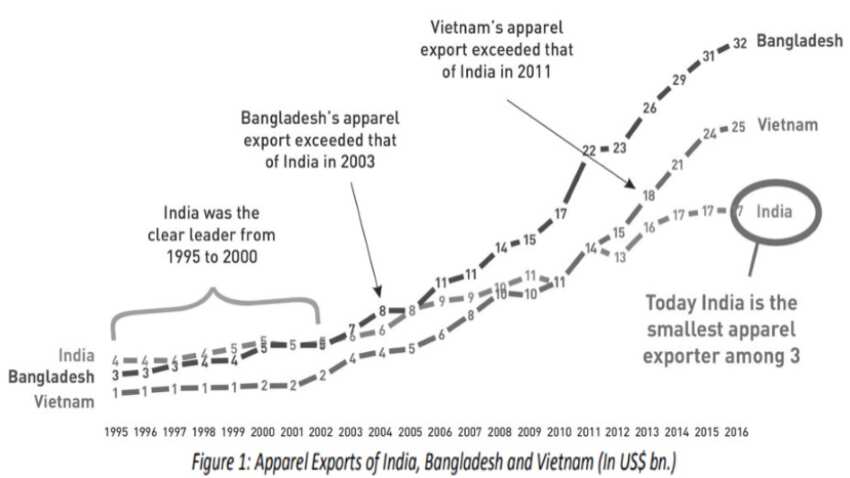China, India, Bangladesh, and Vietnam – this was the order of the major players in the world when it comes to the garment manufacturing sector. Of late, the order has changed to China, Bangladesh, Vietnam, and India. This article focuses on why this change has happened and how India can return to its previous place.
So, what went wrong?
India became a leading player in the garments manufacturing sector because of two major reasons:
- Labour cost was low
- Support for sector through subsidies, duty exemptions, etc.
So, garment manufacturers in India point towards increased labour cost and the fact that the government is no longer offering as many subsidies and duty exemptions. However, the simple truth is labour costs are bound to go up over time (minimum wage has to be revised every five years, as per the Minimum Wages Act, 1948). Also, since we have no choice but to abide by WTO norms, we cannot continue to offer subsidies to the garment manufacturing sector indiscriminately!
Then, what is going right for Bangladesh and Vietnam?
Both enjoy trade advantages that India does not and have access to an cheaper labour force. Bangladesh’s textile industry has quota-free, duty-free access to European markets and duty-free access to the American and Canadian markets, while Vietnam has signed a number of free trade agreements with various nations.
Garment manufacturers in India tried to get the job done by hiring short-term contract workers to avoid high wage bills. But this has backfired in many companies leading to increased operations cost and reduced productivity owing to high labour mobility, less skilled workers, etc. Today, the country has not only lost its cost competitiveness but is also the worst performer among South Asian countries when it comes to on-time delivery and lead times.
What can we do to turn things around? Lowering Lead times is Key
The solution to higher productivity, competitive costs, and on-time delivery is to bring down the lead time of manufacturing, whether it is core products (undergarments, regular tees, jeans, etc.), or fashion items (coats, skirts, activewear, women’s dresses, etc.).
Core products:
Manufacturing them in large batches and then dumping them onto the retailers leads to them suffering from having their working capital blocked for a long time. Retailers would love to order in smaller lots at the same price and with an opportunity to make minor design tweaks subsequently.
Fashion items:
Having to forecast trends and order as much as nine months in advance leads to the problem of mismatches – excess of the ‘duds’ (only to be sold at a discount later) and stock outs of the hits items (sales loss). Retailers would love the luxury of understanding the trends and ordering their requirements late and in smaller lots. This way, they will be able to ensure fewer units of the not-so-popular designs and reorder the hits.
However, these global retailers will trust only those garment manufacturers and exporters who can reliably deliver these items to them before they have disappeared from their store shelves. And this is possible only if manufacturers can reduce the lead times for manufacturing such apparel.
Reducing lead times drastically without increasing costs
Many companies have shown that by adopting a ‘pull’-based model in the supply chain, instead of the current ‘push’ or forecast-based model, companies can drastically reduce lead times, increase productivity and become the preferred supplier of choice to global retailers. For more details on steps to reduce lead time in garment manufacturing and case studies visit: Improving Reliability of Textile Supply Chains
A final word
To be competitive in the evolving global market scenario, Indian garment manufacturers have no option but to shift focus from being ‘mass-manufacturers’ to becoming ‘agile- manufacturers’.
About the author
Chandrachur Datta
Chandrachur (IIM-Ahmedabad), a Consultant with Vector Consulting Group, helps companies implement ‘pull’ based thinking and flow solutions. The textile companies Vector has worked with include Blackberrys, Trident Group, Pratibha Syntex, Raymond Textiles, and Dollar Industries.
(Above mentioned article is a Consumer connect initiative, This article is a paid publication and does not have journalistic/editorial involvement of IDPL, and IDPL claims no responsibility whatsoever.)
Get Latest Business News, Stock Market Updates and Videos; Check your tax outgo through Income Tax Calculator and save money through our Personal Finance coverage. Check Business Breaking News Live on Zee Business Twitter and Facebook. Subscribe on YouTube.
RECOMMENDED STORIES
07:17 PM IST











